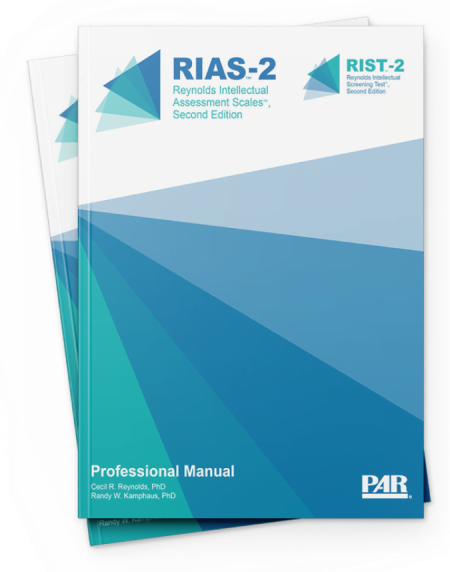
Reynolds Intellectual Assessment Scales, Second Edition rias-2
For: Assess intelligence and its major components in ages 3-94 years
Reading Level: 3 years+
Format: Paper-and-Pencil; Online (via PARiConnect)
Length: 40-45 minutes
Scoring: Hand Scored; Online
Online Forms, Reports, Kits & e-Manuals
All online resources including Forms, Reports, i-Admins, Kits and e-Manuals.
Printed Kits
Click to browse products
Printed Forms & Handscoring Materials
Test forms, response booklets and scoring reference manuals.
Printed Manuals
Physical printed manuals.
RIAS-2 Digital Record Form (each) min order 5
RIAS-2 Digital Record Form with Interpretive Report (each) min order 5
RIAS-2 Digital Record Form with Score Report (each) min order 5
RIAS-2 In-Person e-Stimulus Book
RIAS-2 online Interpretive Report (each) min order 5
RIAS-2 online Score Report (each) min order 5
RIAS-2/RIST-2 online e-Manual (includes Fast Guide)
RIAS-2/RIST-2 Comprehensive Kit
RIAS-2/RIST-2 Introductory Kit
RIAS-2/RIST-2 Remote Comprehensive Kit
RIAS-2 Record Forms (25)
RIAS-2 Response Forms (25)
RIAS-2 Stimulus Book 2
RIAS-2 Stimulus Book 3
RIAS-2 Stimulus Book 4
RIAS-2/RIST-2 Stimulus Book 1
RIAS-2/RIST-2 Professional Manual (includes Fast Guide)
Authors
Cecil R. Reynolds, PhD, and Randy W. Kamphaus, PhD
Description
The RIAS-2 retains all the features that made the original instrument so popular and gives practitioners even more reason to trust this instrument. New speeded processing subtests make this update even more comprehensive than the original instrument.
Features and Benefits
Assesses both verbal and non-verbal intelligence. Verbal intelligence is assessed by measuring verbal problem solving and verbal reasoning, which uses acquired knowledge and skills. Non-verbal intelligence is assessed by measuring reasoning and spatial ability using novel situations and stimuli.
Optional memory subtests available. Verbal and non-verbal memory is assessed via the Composite Memory Index, useful when a broad estimate of memory is desired.
Informs decisions in classification, selection, and educational placement. The RIAS-2 is ideal as a stand-alone intellectual assessment or as part of a clinical battery, when a standardised assessment of intellectual functioning is needed to diagnose specific disorders such as intellectual disabilities or learning disabilities, and for educational placement.
New in the RIAS-2
New speeded processing subtests and index. Two supplemental subtests (one verbal, one nonverbal) combine to create the Speeded Processing Index (SPI). Both the Speeded Naming Task and Speeded Picture Search subtests require far less motor skill than competitive measures.
Greater data for interpretation. Reliable change scores and ability–achievement discrepancies with the AAB are provided.
Revised basal/ceiling rules. Now all basal and ceiling rules for the subtests are consistent with one another and allow for more accurate assessment at the lowest and highest ability level.
Revised/new item content. Items throughout the test have been updated to eliminate confusing or outdated content. Guess What, Odd-Item Out, Verbal Reasoning, What’s Missing, Verbal Memory, and Non-verbal Memory subtests appear in this update, retaining the structure and familiarity of the original measure.
Wider range of T scores. For most grade levels, T score ranges of at least 25 to 75 are available.
Technical Information
Normative data are based on a sample of 2,154 individuals ages 3-94 years from 32 states, representing 2012 U.S. Census proportions for age, gender, geographic region, ethnicity, and years of education.
Data was gathered from the following 12 clinical groups: stroke, dementia, hearing impaired, intellectual disability disorder (child and adult), TBI (child and adult), learning disabilities (child and adult), ADHD (child and adult), and gifted.
Percentile ranks, 90% and 95% confidence intervals, T scores, z-scores, NCEs, and stanines are available.
Internal consistency studies associated with RIAS-2 indexes exceed .90 across age groups.
RIAS-2 indexes correlated highly with RIAS indexes, providing support for the consistency of item content and performance between the original measure and this revision.
Criterion-related validity was assessed by examining correlations between the RIAS-2 indexes and the WISC-IV™, WAIS-IV™, WPPSI-IV™, AAB, FAR, and ChAMP. All correlations were found to be in the strong to very strong range.
NB: Prices are in Australian dollars inclusive of GST. NZ customers need to log in to view ex-GST prices.
 NZ
NZ




